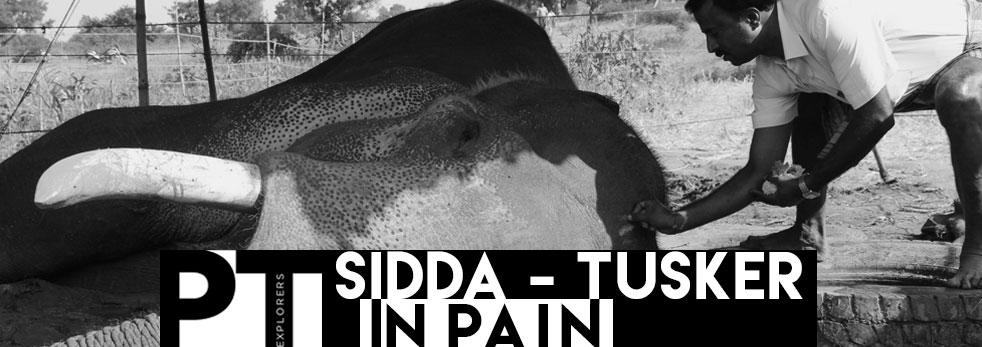
Story & Photos by Raghul Patteri
29 Oct 2016
Sidda, come on… here, take a sip, just one.
Sidda, listen boy…. Just one sip…
Cajoling, coercing….. Like a parent getting his child to drink milk. Only thing, the ‘child’ here is a fully grown wild tusker and the ‘parent is a concerned villager trying to get the pachyderm to take a sip of water. This is the heart wrenching tale of Sidda, a 35 year old, wild male Asian elephant. Sidda calls the forests of the Bannerghatta National Park in south India, home. He is used to wandering to other nearby forest ranges of Magadi. Towards the end of August, Sidda had wandered out his home forest and while crossing an area fallen into a ditch and injured himself. There are reports that the accident happened when he was chased by irate villagers. A massive elephant taking a fall is no laughing matter. Sidda sustained a fracture to his right forelimb and many other abrasions to his body. The tusker then limped his way to the backwaters of Manchanabele dam and took refuge in the soothing waters. The natural buoyancy of the water allowed him to take pressure off his leg and ease the pain. From the starting of September the animal has been staying in the backwaters. Forest department, wildlife activists and villagers have been providing food at the shores to help strengthen the animal. Efforts at treating the animal with medicines concealed in food has not had good results and the tusker’s condition has only deteriorated.
There was no major step taken to treat the animal. Animal lovers spearheaded by two groups, young India wild India and Friends of wild life, started a relentless campaign with the support of concerned villagers. Print and visual media also took up the cause. After almost one and a half months of struggle, last week officials with the help of two tamed guide elephants, managed to coax Sidda out of the water. He was then sedated and administered treatment. Doctors removed puss and dead tissue form his leg and other wounds and administered antibiotics. Sadly septicemia has already set in and it was an uphill task for recovery. Still the animal seemed to be improving and on the path of recovery. But this lasted only couple of days and the beginning of this week, Sidda went down on his left side at the shores of the backwaters and has not stood up till now. Treatment is continuing, he is being administered fluids and medicines. Villagers are also pitching in helping to feed the tusker. Elephant experts warn that it is always an uphill journey for an elephant with a major injury to the trunk or legs.
This is a vilage which do get it's share of wildlife intrusion, but the reaction of the villagers has been heartwarming. They are caring for the tusker with utmost dedication. With great care they wash him and perform puja for him applying vermillion and turmeric to his forehead which is a Hindu ritualistic sign of protection and purity. They hand feed him sugarcane and corn, coaxing him to eat so that he may regain strength. But the most touching sight is of them willing him to drink water from plastic buckets. Buckets are placed near his trunk and they call out his name, patting his limp trunk, willing him to lift it and drink from the bucket. After much coaxing the tusker lifts his trunk with difficulty and syphons out the water and takes a sip, but that is it. Coercion from the villagers goes in vain. It is evident that the animal is in great pain. He lies under a temporary tent, the only sound coming from him a constant sighing, like that of a man weary of life. He is weak and does not move much other than the occasional shifting of his swollen right foreleg and the halfhearted movement of his trunk. It is a race against time to get him to stand up, for an elephant’s bulk is not designed for lying down. The only way for him to stand up is to eat enough to regain his strength back. Sidda is no stranger to injuries, he is partially blind in the right eye, his tail has been mutilated and the end of the trunk damaged in an old fight with another tusker and now this! Misery seems to be piling up for this elephant.
Was Sidda a victim of human – wildlife conflict? Did his fall result from a chase by villagers? Have human settlements spread to crucial forest corridors, hindering wildlife movement which is critical for their survival. Our forests have already shrunk. Where there used to be well defined corridors connecting different forest ranges, now there are small patches of woods sometimes obstructed by highways or farmlands which acts as the pathways for animal movement. This is one of the main reasons why animals stray into human settlements, resulting in conflict and both humans and wildlife are affected.
Courtesy: Ashok Hallur & Manjunath N for information and guidance.
Copyright © 2024. All rights reserved. PAWS TRAILS EXPLORERS